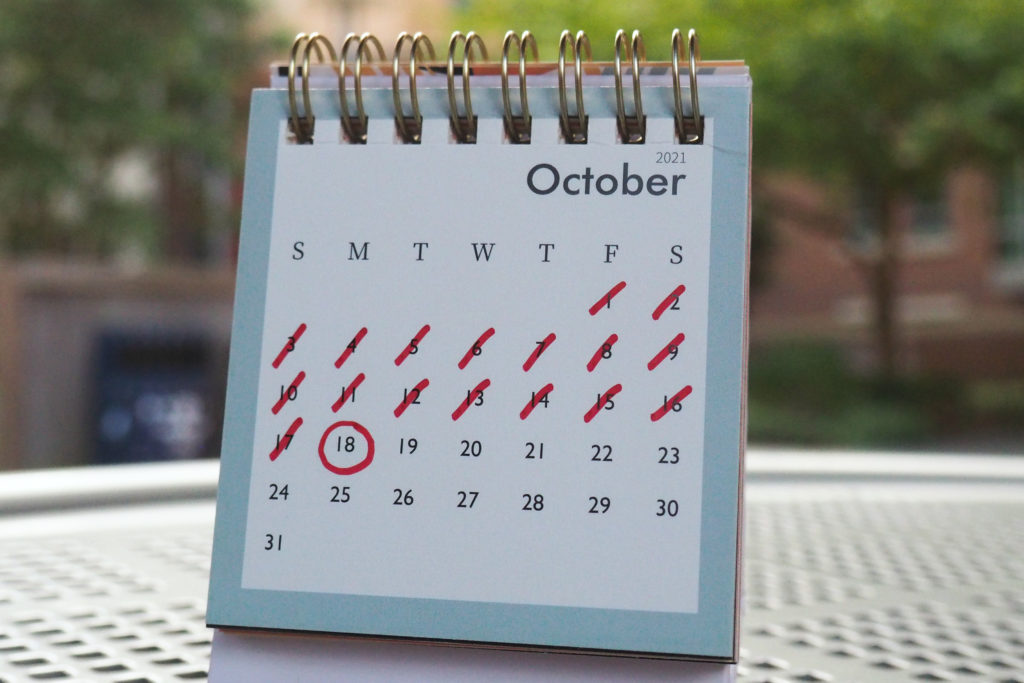The pressure of midterm season and academic fatigue of the in-person semester may be wearing on you, but take comfort in the fact there are ways to re-energize and re-focus.
Psychologists define burnout as the psychological response to chronic stressors, leaving those who experience the syndrome feeling exhausted, detached from their work and a lack of accomplishment, according to 2016 research published in the journal World Psychiatry. Finding extra time in your schedule to devote to your mental health may seem daunting, but we’ve compiled a list of simple tips to re-energize and refocus to hold you over until winter break.
Find time for physical activity
Healthy habits like eating well, drinking plenty of water and exercise can go a long way for your mental well-being. Even if you can accommodate 15 to 20 minutes a day, physical activity decreases stress and anxiety and helps to improve sleep and concentration.
The Lerner Health and Wellness Center offers a weekly schedule of group fitness classes both in person and online. Semester passes for the classes are $79 – providing access to mat pilates, Zumba, HIIT, weight training and more – while the cost of a drop-in class is $14. For something more flexible, GW Campus Recreation’s YouTube channel offers hundreds of free workout videos of yoga, barre and pilates classes to follow at home.
Get out for some fresh air
Fresh air and a change of scenery can give you a dose of vitamin D, improve your concentration and reduce stress. To stimulate your brain, consider taking 15 to 30 minutes out of your day to go for a brisk walk. Check out GW Campus Recreation’s list of walking and running routes for a quick three-quarter mile pass around campus to a six mile stroll around the National Mall. For a fix of greenery, walk to Rock Creek Park in northwest D.C. or explore the free Smithsonian Sculpture Garden on Independence Ave.
Schedule your break time
Stay focused for longer by working in incremental periods and budgeting in break time using the Pomodoro Technique to manage your time. This time management tool, created by consultant Francesco Cirillo in the 1980s, strengthens your concentration skills by designating segments of your work time for intentional relaxation in order to sustain your focus in the long run.
For this technique, choose a task you would like to get done and set a timer for 25 minutes to begin working on it. When the timer ends, do something else for five to ten minutes before resetting the timer for another 25 minutes and continuing to work. Every four intervals of 25 minutes, take a longer break of 20 or 30 minutes.
Set boundaries
As tempting as it is to check your email every waking moment, set a specific time when you can realistically power down for the day. Put your phone on do not disturb mode, set screen time limits for distracting apps or simply plug in your phone and computer across the room when you’re done for the night.
The pandemic trained us to let work bleed into all aspects of our lives with everyone only a text or email away at all times. Pick a time and space to work that is separate from the space you use to relax and fill it with something you enjoy. Additionally, be realistic about the workload you can handle. Taking on extra assignments, activities and obligations may feel productive in the moment, but can stretch you too thin and cause you to burnout.
Practice mindfulness
Taking a few minutes for mindfulness when you feel yourself getting overwhelmed can be a game changer. The best part is, you don’t even have to move from your desk. Start with a few simple breathing exercises like the 4-7-8 method recommended by health and wellness literature like Womens’ Health Magazine. For this exercise, simply close your eyes, breathe in for four counts, hold the breath for seven counts and exhale for eight counts. If you’re looking for a longer, guided meditation try the website mindful, where you can find a wide variety of meditations, daily practices and mindfulness courses to fit your needs.
Apps like Calm and Headspace also provide tailored meditations, breathing exercises and even celebrity narrated stories for you to center your focus and calm your nerves with. At the very least, you can listen to Harry Styles narrate a nighttime meditation for you. The Calm app is priced at $14.99 a month and provides relaxing meditations and sounds for all moods and stress levels. Headspace costs $9.99 a year with the student plan and offers meditations, audios for sleep and guided yoga and movement sessions. Or, you can simply search for a free meditation video on Youtube to enjoy.
Talk to someone
Burnout can usher in feelings of loneliness and inadequacy and you may feel it seeping into your academic performance and social life. Talking to a professional can help you address this and work to alleviate the burden of these emotions monopolizing your time and mental space.
A comprehensive list of mental health resources can be found here, which includes university services like psychological counseling, self help resources as well as outside services like telehealth websites Talkspace and Betterhelp.







